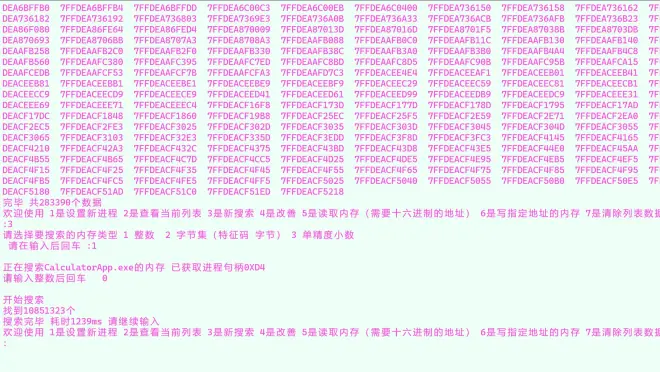淺談內(nèi)存搜索

? ? ???????????????????????????????????????????????????????????

先來細(xì)談原理

????對系統(tǒng)進(jìn)程遍歷 打印 獲取進(jìn)程?PID?句柄?????????
?????????
以下簡單的控制臺應(yīng)用程序獲取正在運(yùn)行的進(jìn)程列表。 首先,該 GetProcessList 函數(shù)使用 CreateToolhelp32Snapshot 拍攝系統(tǒng)中當(dāng)前正在執(zhí)行的進(jìn)程快照,然后使用 Process32First 和 Process32Next 遍歷快照中記錄的列表。 對于每個進(jìn)程,GetProcessList依次調(diào)用ListProcessModules遍歷模塊列表中所述的函數(shù),以及ListProcessThreads遍歷線程列表中所述的函數(shù)。
一個簡單的錯誤報告函數(shù) printError顯示任何失敗的原因,這通常源于安全限制。 例如, OpenProcess 對于 Idle 和 CSRSS 進(jìn)程失敗,因?yàn)樗鼈兊脑L問限制會阻止用戶級代碼打開它們。
#include <windows.h>
#include <tlhelp32.h>
#include <tchar.h>
// ?Forward declarations:
BOOL GetProcessList( );
BOOL ListProcessModules( DWORD dwPID );
BOOL ListProcessThreads( DWORD dwOwnerPID );
void printError( TCHAR* msg );
int main( void )
{
?GetProcessList( );
?return 0;
}
BOOL GetProcessList( )
{
?HANDLE hProcessSnap;
?HANDLE hProcess;
?PROCESSENTRY32 pe32;
?DWORD dwPriorityClass;
?// Take a snapshot of all processes in the system.
?hProcessSnap = CreateToolhelp32Snapshot( TH32CS_SNAPPROCESS, 0 );
?if( hProcessSnap == INVALID_HANDLE_VALUE )
?{
? ?printError( TEXT("CreateToolhelp32Snapshot (of processes)") );
? ?return( FALSE );
?}
?// Set the size of the structure before using it.
?pe32.dwSize = sizeof( PROCESSENTRY32 );
?// Retrieve information about the first process,
?// and exit if unsuccessful
?if( !Process32First( hProcessSnap, &pe32 ) )
?{
? ?printError( TEXT("Process32First") ); // show cause of failure
? ?CloseHandle( hProcessSnap ); ? ? ? ? ?// clean the snapshot object
? ?return( FALSE );
?}
?// Now walk the snapshot of processes, and
?// display information about each process in turn
?do
?{
? ?_tprintf( TEXT("\n\n=====================================================" ));
? ?_tprintf( TEXT("\nPROCESS NAME: ?%s"), pe32.szExeFile );
? ?_tprintf( TEXT("\n-------------------------------------------------------" ));
? ?// Retrieve the priority class.
? ?dwPriorityClass = 0;
? ?hProcess = OpenProcess( PROCESS_ALL_ACCESS, FALSE, pe32.th32ProcessID );
? ?if( hProcess == NULL )
? ? ?printError( TEXT("OpenProcess") );
? ?else
? ?{
? ? ?dwPriorityClass = GetPriorityClass( hProcess );
? ? ?if( !dwPriorityClass )
? ? ? ?printError( TEXT("GetPriorityClass") );
? ? ?CloseHandle( hProcess );
? ?}
? ?_tprintf( TEXT("\n ?Process ID ? ? ? ?= 0x%08X"), pe32.th32ProcessID );
? ?_tprintf( TEXT("\n ?Thread count ? ? ?= %d"), ? pe32.cntThreads );
? ?_tprintf( TEXT("\n ?Parent process ID = 0x%08X"), pe32.th32ParentProcessID );
? ?_tprintf( TEXT("\n ?Priority base ? ? = %d"), pe32.pcPriClassBase );
? ?if( dwPriorityClass )
? ? ?_tprintf( TEXT("\n ?Priority class ? ?= %d"), dwPriorityClass );
? ?// List the modules and threads associated with this process
? ?ListProcessModules( pe32.th32ProcessID );
? ?ListProcessThreads( pe32.th32ProcessID );
?} while( Process32Next( hProcessSnap, &pe32 ) );
?CloseHandle( hProcessSnap );
?return( TRUE );
}
BOOL ListProcessModules( DWORD dwPID )
{
?HANDLE hModuleSnap = INVALID_HANDLE_VALUE;
?MODULEENTRY32 me32;
?// Take a snapshot of all modules in the specified process.
?hModuleSnap = CreateToolhelp32Snapshot( TH32CS_SNAPMODULE, dwPID );
?if( hModuleSnap == INVALID_HANDLE_VALUE )
?{
? ?printError( TEXT("CreateToolhelp32Snapshot (of modules)") );
? ?return( FALSE );
?}
?// Set the size of the structure before using it.
?me32.dwSize = sizeof( MODULEENTRY32 );
?// Retrieve information about the first module,
?// and exit if unsuccessful
?if( !Module32First( hModuleSnap, &me32 ) )
?{
? ?printError( TEXT("Module32First") ); ?// show cause of failure
? ?CloseHandle( hModuleSnap ); ? ? ? ? ? // clean the snapshot object
? ?return( FALSE );
?}
?// Now walk the module list of the process,
?// and display information about each module
?do
?{
? ?_tprintf( TEXT("\n\n ? ? MODULE NAME: ? ? %s"), ? me32.szModule );
? ?_tprintf( TEXT("\n ? ? Executable ? ? = %s"), ? ? me32.szExePath );
? ?_tprintf( TEXT("\n ? ? Process ID ? ? = 0x%08X"), ? ? ? ? me32.th32ProcessID );
? ?_tprintf( TEXT("\n ? ? Ref count (g) ?= 0x%04X"), ? ? me32.GlblcntUsage );
? ?_tprintf( TEXT("\n ? ? Ref count (p) ?= 0x%04X"), ? ? me32.ProccntUsage );
? ?_tprintf( TEXT("\n ? ? Base address ? = 0x%08X"), (DWORD) me32.modBaseAddr );
? ?_tprintf( TEXT("\n ? ? Base size ? ? ?= %d"), ? ? ? ? ? ? me32.modBaseSize );
?} while( Module32Next( hModuleSnap, &me32 ) );
?CloseHandle( hModuleSnap );
?return( TRUE );
}
BOOL ListProcessThreads( DWORD dwOwnerPID )
{
?HANDLE hThreadSnap = INVALID_HANDLE_VALUE;
?THREADENTRY32 te32;
?// Take a snapshot of all running threads ?
?hThreadSnap = CreateToolhelp32Snapshot( TH32CS_SNAPTHREAD, 0 );
?if( hThreadSnap == INVALID_HANDLE_VALUE )
? ?return( FALSE );
?// Fill in the size of the structure before using it.
?te32.dwSize = sizeof(THREADENTRY32);
?// Retrieve information about the first thread,
?// and exit if unsuccessful
?if( !Thread32First( hThreadSnap, &te32 ) )
?{
? ?printError( TEXT("Thread32First") ); // show cause of failure
? ?CloseHandle( hThreadSnap ); ? ? ? ? ?// clean the snapshot object
? ?return( FALSE );
?}
?// Now walk the thread list of the system,
?// and display information about each thread
?// associated with the specified process
?do
?{
? ?if( te32.th32OwnerProcessID == dwOwnerPID )
? ?{
? ? ?_tprintf( TEXT("\n\n ? ? THREAD ID ? ? ?= 0x%08X"), te32.th32ThreadID );
? ? ?_tprintf( TEXT("\n ? ? Base priority ?= %d"), te32.tpBasePri );
? ? ?_tprintf( TEXT("\n ? ? Delta priority = %d"), te32.tpDeltaPri );
? ? ?_tprintf( TEXT("\n"));
? ?}
?} while( Thread32Next(hThreadSnap, &te32 ) );
?CloseHandle( hThreadSnap );
?return( TRUE );
}
void printError( TCHAR* msg )
{
?DWORD eNum;
?TCHAR sysMsg[256];
?TCHAR* p;
?eNum = GetLastError( );
?FormatMessage( FORMAT_MESSAGE_FROM_SYSTEM | FORMAT_MESSAGE_IGNORE_INSERTS,
? ? ? ? NULL, eNum,
? ? ? ? MAKELANGID(LANG_NEUTRAL, SUBLANG_DEFAULT), // Default language
? ? ? ? sysMsg, 256, NULL );
?// Trim the end of the line and terminate it with a null
?p = sysMsg;
?while( ( *p > 31 ) || ( *p == 9 ) )
? ?++p;
?do { *p-- = 0; } while( ( p >= sysMsg ) &&
? ? ? ? ? ? ? ? ? ? ? ? ?( ( *p == '.' ) || ( *p < 33 ) ) );
?// Display the message
?_tprintf( TEXT("\n ?WARNING: %s failed with error %d (%s)"), msg, eNum, sysMsg );
}-----選自微軟開發(fā)文檔? ? ??
????使用window的api 對目標(biāo)進(jìn)程讀取?
ULONG ReadMemory(
?ULONG offset,
?PVOID lpBuffer,
?ULONG cb,
?PULONG lpcbBytesRead
);-----選自微軟開發(fā)文檔? ?記得加windows.h

????????搜索算法? KMP
? ? ? ? ? ? ? ? ?具體的算法原理 介紹 再此暫不涉及?KMP算法的介紹
?????????????????????KMP是字符串匹配算法 他的作用是用來匹配字節(jié)在內(nèi)存中的位置
????????????????????字節(jié)的類型?
unsigned charKMP算法的簡單實(shí)現(xiàn) 寫的不規(guī)范請見諒?
set<UINT_PTR> address_list;
void KMP(unsigned char* zichuan, unsigned char* muchuan,UINT_PTR len_zi,UINT_PTR len_mu,UINT_PTR fujia=0) {
if (len_zi <= len_mu) {
int* next = (int*)init_ptr(len_mu * 4);
int prefix_len = 0;//當(dāng)前的共同前后綴長度
for (int i = 1; i <= len_mu - 1;) {
if (muchuan[prefix_len] == muchuan[i]) {
prefix_len += 1;
next[i] = prefix_len;
i += 1;
}//相同的時候很簡單 如上
else {
//接下來分為倆種 如果當(dāng)前前后綴的相同長度為0 直接可以跳過賦0
if (prefix_len == 0) {
next[i] = 0;
i += 1;
}
else {
prefix_len = next[prefix_len - 1];//將當(dāng)前長度設(shè)置為前綴中相同位置的前一個 然后進(jìn)入下一次循環(huán) i不變
}
}
}
//printf("\n開始執(zhí)行KMP算法\n\n");
/*上面是計(jì)算 next
這里開始 查找*/ int i = 0/*指向母串的指針*/, j = 0/*指向子串的指針*/;
while (i <= len_mu - 1) {
/*printf("第%d個 匹配中 : ?", i);*/
/*if (j >= 子串長度) {
i = i - j + 2;
j = 0;
j = 0;
}*/
if (zichuan[j] == muchuan[i]) {
i += 1;
j += 1;
/*printf("相等\n");*/
}
else if (j > 0) {
j = next[j - 1];//通過next數(shù)組回退
/*printf("回退\n");*/
}
else {
/*printf("i進(jìn)一位 不用回退\n");*/
i += 1;//子串第一個就匹配失敗 也就不用回退了
}
/*printf(" ? ? 當(dāng)前j值%d ? ? ?\n", j);*/
if (j == len_zi) {
address_list.insert(i - j + fujia);
/*Sleep(1000000);*/
i = i - j + 2;
j = 0;
/*printf("\n找到 在 %d 位\n\n", i-j);*/
};//匹配成功 插入set 注意是i-j
}
free(next);
}
}接下來就是如何組裝他們了

首先 遍歷進(jìn)程獲取到權(quán)限句柄
HANDLE handle然后 讀取目標(biāo)進(jìn)程的內(nèi)存
這里我們可以優(yōu)化為一次讀取一塊內(nèi)存 然后對內(nèi)存塊使用KMP算法 加上內(nèi)存塊的首地址 便是我們想要得到的地址了 沒有考慮內(nèi)存對齊的情況 大佬在寫的時候可以修改
void search(HANDLE hprocess,unsigned char* zijieji,UINT_PTR len,UINT_PTR startaddress=0,UINT_PTR finaladdress= 0x7fffffffffff)
{
unsigned char arBytes[BLOCKMAXSIZE]; // 409600的數(shù)據(jù)緩沖區(qū),用來存放一個內(nèi)存頁
int i = 0;
address_list.clear();
/*int weishu = len;*/
unsigned long long BlockSize;
MEMORY_BASIC_INFORMATION mbi;
UINT_PTR address_now = startaddress;
/*VirtualQueryEx(hprocess, (LPCVOID)(address_now), &mbi, sizeof(mbi));*/
while (address_now<finaladdress && VirtualQueryEx(hprocess, (LPCVOID)(address_now), &mbi, sizeof(mbi))!=0)
{
//獲取可讀可寫和可讀可寫可執(zhí)行的內(nèi)存塊
if (mbi.Protect == PAGE_READWRITE || mbi.Protect == PAGE_EXECUTE_READWRITE)
{
i = 0;
BlockSize = mbi.RegionSize;
//搜索這塊內(nèi)存
if (BlockSize < 0) {
break;
}
while (BlockSize >= BLOCKMAXSIZE)
{
if (ReadProcessMemory(hprocess, (LPCVOID)(address_now + (BLOCKMAXSIZE * i)), arBytes, BLOCKMAXSIZE, NULL)) {
KMP(zijieji, arBytes, len, BLOCKMAXSIZE, address_now + (BLOCKMAXSIZE * i));
}
BlockSize -= BLOCKMAXSIZE;
i++;
}
if (ReadProcessMemory(hprocess, (LPCVOID)(address_now + (BLOCKMAXSIZE * i)), arBytes, BlockSize, NULL)) {
KMP(zijieji, arBytes, len, BlockSize, address_now + (BLOCKMAXSIZE * i));
}
}
address_now += mbi.RegionSize;
}
}將讀取到的內(nèi)存塊進(jìn)行匹配 最后對容器打印輸出便完成啦
不過不如ce快 應(yīng)該是沒進(jìn)行內(nèi)存對齊的問題()可以多開兩個線程加快速度
附上搜索截圖



